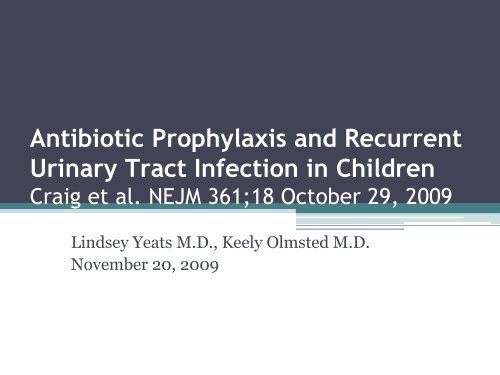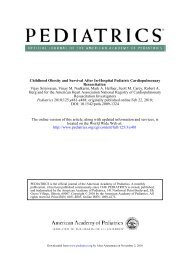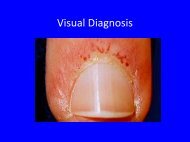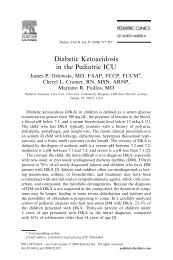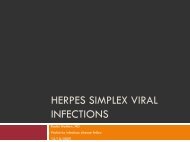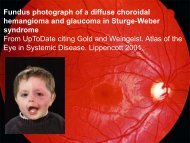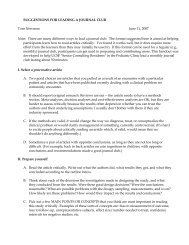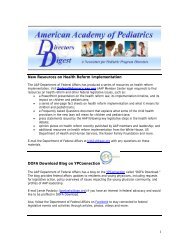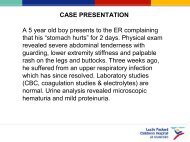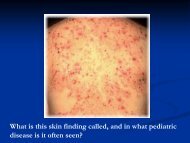Antibiotic Prophylaxis and Recurrent Urinary Tract Infection in Children
Antibiotic Prophylaxis and Recurrent Urinary Tract Infection in Children
Antibiotic Prophylaxis and Recurrent Urinary Tract Infection in Children
You also want an ePaper? Increase the reach of your titles
YUMPU automatically turns print PDFs into web optimized ePapers that Google loves.
<strong>Antibiotic</strong> <strong>Prophylaxis</strong> <strong>and</strong> <strong>Recurrent</strong><br />
<strong>Ur<strong>in</strong>ary</strong> <strong>Tract</strong> <strong>Infection</strong> <strong>in</strong> <strong>Children</strong><br />
Craig et al. NEJM 361;18 October 29, 2009<br />
L<strong>in</strong>dsey Yeats M.D., Keely Olmsted M.D.<br />
November 20, 2009
• Today’s Lunch = mystery meat
Outl<strong>in</strong>e<br />
• Introduction<br />
• Methods<br />
• Results<br />
• Discussion<br />
• Conclusion
Introduction<br />
A brief history of antibiotics for UTI<br />
<strong>Prophylaxis</strong><br />
• Why?<br />
▫ 2% of boys, 8% of girls by age 7<br />
▫ Between 830% experience recurrent UTI*<br />
▫ Longterm morbidity with renal damage <strong>in</strong> 5% of kids<br />
• The debate:<br />
▫ Pro: <strong>Antibiotic</strong>s have long been used to prevent<br />
recurrent UTI – <strong>in</strong> VUR <strong>and</strong> <strong>in</strong> recurrent UTI<br />
▫ Con: Doesn’t it just create multidrug resistant<br />
<strong>in</strong>fections, <strong>and</strong> does it really prevent end organ<br />
damage? And the side effects?
Sample of articles <strong>in</strong> past on ppx:<br />
• Saux et al. CMAJ 2000<br />
▫ M<strong>in</strong>imeta (6 case <strong>and</strong> cohort studies of quality 02/5)<br />
▫ Normal GU (Tx group: 04.0 per 10 patientyears vs. 4.016.7 for<br />
control)<br />
▫ Neurogenic bladders (tx group: 2.9 <strong>and</strong> 17.1 per 10 patientyears<br />
vs 1.5 <strong>and</strong> 33.0 for the control groups)<br />
▫ Concluded data severely lack<strong>in</strong>g<br />
• Williams et al. Cochrane Database Syst Rev. 2006<br />
▫ Reviewed 8 studies compar<strong>in</strong>g antibiotics, <strong>and</strong> compar<strong>in</strong>g abx<br />
with placebo<br />
▫ One said nitrofuranto<strong>in</strong> better than TMPSMX, but had worse<br />
adherence from side effects<br />
▫ Another said cefixime better than nitrofuranto<strong>in</strong>, but more<br />
adverse effects<br />
▫ Review of 5, gives RR 0.44 of recurrent positive ur<strong>in</strong>e culture with<br />
abx<br />
▫ more studies needed.
• Wheeler et al (2004)<br />
▫ Metareview of children with VUR<br />
▫ No significant difference between abx ppx <strong>and</strong> none<br />
▫ No difference <strong>in</strong> renal parenchymal damage<br />
• Conrad et al (2007)<br />
▫ Increased recurrent UTI with age 35, white, grade 45 VUR<br />
▫ No significant difference with antibiotic ppx<br />
▫ But <strong>in</strong>creased risk of antimicrobial resistance (HR 7.5)<br />
• NICE guidel<strong>in</strong>es (UK)<br />
▫ Interest<strong>in</strong>g review of UTI sett<strong>in</strong>g UK policy<br />
▫ Has extensive lit review<br />
▫ Basis of our imag<strong>in</strong>g guidel<strong>in</strong>es for Valley
• Essentially, there are no RCT regard<strong>in</strong>g subject<br />
• Widely variable practice
Design<br />
• R<strong>and</strong>omized, double bl<strong>in</strong>ded, control trial of<br />
antibiotic versus placebo for 12 months.<br />
• Computer r<strong>and</strong>omization accord<strong>in</strong>g to<br />
▫ Center, referral source, frequency of prior UTIs,<br />
reflux status, age <strong>and</strong> sex.
Methods<br />
• Four centers <strong>in</strong> Australia<br />
• <strong>Children</strong> 018 years<br />
• One symptomatic UTI<br />
• All grades of VUR<br />
• Repeat UTIs
Def<strong>in</strong>itions<br />
• Symptomatic UTI<br />
▫ Symptoms consistent with <strong>in</strong>fection<br />
▫ Positive ur<strong>in</strong>e culture<br />
Pathogenic organism <strong>in</strong> suprapubic tap<br />
10,000 colony form<strong>in</strong>g units from catheter<br />
100,000 CFUof a s<strong>in</strong>gle organism via clean catch.
Inclusion Criteria<br />
• <strong>Children</strong> who had<br />
▫ completed shortterm treatment<br />
▫ Undergone renal tract imag<strong>in</strong>g (if <strong>in</strong>dicated)<br />
▫ Cl<strong>in</strong>ically asymptomatic before recruitment
Study Arms<br />
• <strong>Children</strong> received either<br />
▫ Trimethoprimsulfamethoxazole (Bactrim, Roche)<br />
▫ Placebo (matched for color, taste <strong>and</strong> texture)
Patient enrollment
Patient Characteristics
Imag<strong>in</strong>g<br />
• Not required, performed accord<strong>in</strong>g<br />
to local protocol<br />
• Renal US, VCUG, renal sc<strong>in</strong>tigraphy.<br />
• 89% centrally reviewed<br />
• VUR graded accord<strong>in</strong>g to the <strong>in</strong>ternational<br />
reflux study.<br />
• Renal damage graded accord<strong>in</strong>g to Goldraich<br />
criteria.
Study Medication<br />
• All patients received TMPSMX for 2weeks<br />
dur<strong>in</strong>g the run<strong>in</strong> period.<br />
• Dose: 2mg/kg TMP, 10mg/kg SMX daily<br />
• Dispensed to study group at every 3month
Adherence<br />
• Assessed at 3 month <strong>in</strong>tervals<br />
▫ Comparisons of drug levels <strong>in</strong> bottles<br />
▫ Direct question<strong>in</strong>g<br />
▫ Patient diaries
Follow‐up<br />
• At three month <strong>in</strong>tervals for 12 months<br />
• Height, weight <strong>and</strong> blood pressure assessed<br />
• Adherence assessed<br />
• Primary <strong>and</strong> secondary outcomes assessed via<br />
patient diaries <strong>and</strong> medical records.
Primary <strong>and</strong> Secondary outcomes<br />
• Primary<br />
▫ Symptomatic ur<strong>in</strong>ary tract <strong>in</strong>fection with<strong>in</strong> 12 months<br />
of start<strong>in</strong>g prophylaxis<br />
If <strong>in</strong>fected prophylaxis was stopped <strong>and</strong> treatment given<br />
• Secondary<br />
▫ UTI with fever<br />
▫ Hospitalization for other causes<br />
▫ Concomitant antibiotics for other causes<br />
▫ Deterioration via sc<strong>in</strong>tigraphy of kidneys<br />
▫ Resistance to Bactrim (added dur<strong>in</strong>g editorial review)
Goals<br />
• Recruit 780 children<br />
• Reduce absolute risk by 10%<br />
• 80% power<br />
• Type 1 error of 5%<br />
• Ongo<strong>in</strong>g treatment risk of 20%
Statistical Analysis<br />
• UTI<br />
▫ Time to event analysis<br />
▫ Log rank test<br />
• Other outcomes<br />
▫ Chisquare test
Statistical Analysis<br />
• Cox proportionalhazards regression<br />
▫ The effect of a treatment under study has a<br />
multiplicative effect on the subject's hazard rate.<br />
▫ Unadjusted hazard ratio<br />
▫ Adjust for significant stratify<strong>in</strong>g variables<br />
▫ Effect modification <strong>in</strong> secondary analyses<br />
• KaplanMeier<br />
▫ Estimates of children with UTIs<br />
• Number needed to treat
Statistical Analysis<br />
• Cox model<br />
▫ Pirori subgroup analysis of children accord<strong>in</strong>g to<br />
reflux grade.<br />
• Post hoc subgroup analyses<br />
▫ <strong>Antibiotic</strong> sensitivities<br />
• Hazard ratio <strong>and</strong> absolute risk<br />
▫ Treatment effects
Results
Patient Characteristics
Discont<strong>in</strong>uation of <strong>in</strong>tervention<br />
▫ 30% by 12 mo for reason other than UTI<br />
Similar adverse reactions <strong>in</strong> both groups though not<br />
specified<br />
▫ No difference <strong>in</strong> nonadherence<br />
▫ 2% dropped out for mild adverse drug reaction
Time to symptomatic UTI for all patients
Primary Outcome<br />
• UTI diagnosed <strong>in</strong> 36 (13%) vs 55 (19%) patients<br />
<strong>in</strong> treatment vs placebo groups (P=0.02)<br />
• Hazard Ratio 0.61 (0.40.93) <strong>in</strong> antibiotic grp<br />
• Number Needed to Treat is 14<br />
• Abx group favored across age, sex, reflux status,<br />
# of previous UTI, or h/o abx resistance<br />
• EXCEPTION – h/o UTI caused by organism<br />
resistant to TMPSMX
Effect of antibiotics on risk for<br />
symptomatic UTI
Secondary Outcomes
Time to symptomatic UTI
Discussion<br />
• Longterm, lowdose trimethoprim<br />
sulfamethoxazole was associated with a modest<br />
decrease <strong>in</strong> symptomatic UTI <strong>in</strong> predisposed<br />
children.<br />
• Absolute risk reduction of 6%<br />
• Decreased risk of febrile UTI
Discussion<br />
• The benefit of therapy is greatest dur<strong>in</strong>g the first<br />
6 months<br />
• Over time the susceptibility patterns change<br />
▫ Increased risk of pathogenic bacteria<br />
▫ Increased risk of symptomatic UTI caused by<br />
resistant organisms<br />
• Likely long term antibiotic use does not<br />
predispose to other <strong>in</strong>fections
Previous Data<br />
• Limited data from previous r<strong>and</strong>omized,<br />
controlled trials.<br />
▫ Four trials tended to favor prophylaxis<br />
▫ 171 children <strong>in</strong> all four studies<br />
▫ 32 children with reflux<br />
• Accepted as st<strong>and</strong>ard of care for 20 years
Recent changes<br />
• Five r<strong>and</strong>omized, controlled trials <strong>in</strong> children<br />
with <strong>and</strong> without reflux<br />
▫ Showed no benefit of prophylactic antibiotics<br />
▫ None placebo controlled or assessed adherence<br />
▫ Underpowered with 100218 patients<br />
• Different results<br />
▫ Lack of adherence, lack of power, unbalanced co<br />
<strong>in</strong>terventions.
Current research<br />
• An ongo<strong>in</strong>g placebo controlled r<strong>and</strong>omized<br />
<strong>in</strong>tervention for children with vesicoureteral<br />
reflux (RIVUR study)<br />
▫ Datal<strong>in</strong>kage cohort study showed no benefit of<br />
antibiotic prophylaxis
Limitations<br />
• Study not powered to f<strong>in</strong>d risk of new kidney<br />
damage<br />
• Enrolled fewer patients than desired<br />
• Low percentage of circumcised males<br />
• Group<strong>in</strong>g of patients with VUR
Recommendations<br />
• Use of TMPSMX <strong>in</strong> children at high risk for<br />
<strong>in</strong>fection<br />
▫ Females<br />
▫ VUR<br />
▫ <strong>Recurrent</strong> UTI<br />
• Not rout<strong>in</strong>ely recommended <strong>in</strong> children with a<br />
s<strong>in</strong>gle symptomatic UTI<br />
• Not recommended <strong>in</strong> children with congenital<br />
hydronephrosis or sibl<strong>in</strong>gs with reflux, but no<br />
UTI
Conclusions<br />
• Long term, lowdose antibiotic use was<br />
associated with small but significant reduction<br />
<strong>in</strong> the absolute risk of symptomatic UTI <strong>in</strong><br />
predisposed children.<br />
• May reduce the likelihood that antibiotics will be<br />
required for other <strong>in</strong>fections.
References<br />
• Conway et al. <strong>Recurrent</strong> ur<strong>in</strong>ary tract <strong>in</strong>fections <strong>in</strong> children: risk factors <strong>and</strong><br />
association with prophylactic antimicrobials. JAMA. 2007 Jul<br />
11;298(2):17986.<br />
• Saux et al. Evaluat<strong>in</strong>g the benefits of antimicrobial prophylaxis to prevent<br />
ur<strong>in</strong>ary tract <strong>in</strong>fections <strong>in</strong> children: a systematic review. CMAJ 2000 Sep<br />
5;163(5):5239.<br />
• Shaikh et al. Longterm management <strong>and</strong> prevention of ur<strong>in</strong>ary tract<br />
<strong>in</strong>fections <strong>in</strong> children. Uptodate.com. Last update April 9, 2009.<br />
• <strong>Ur<strong>in</strong>ary</strong> <strong>Tract</strong> <strong>Infection</strong> <strong>in</strong> <strong>Children</strong>. National Institute of Health <strong>and</strong><br />
Cl<strong>in</strong>ical Excellence guidel<strong>in</strong>es. (2007) http://guidance.nice.org.uk/CG54.<br />
Accessed 11/19/2009.<br />
• Wheeler et al. Interventions for primary vesicoureteric reflux. (Cochrane<br />
Review). Cochrane Database of Systematic Reviews, Issue 3, 2004.<br />
• Williams et al. Longterm antibiotics for prevent<strong>in</strong>g recurrent ur<strong>in</strong>ary tract<br />
<strong>in</strong>fection <strong>in</strong> children. Cochrane Database Syst Rev. 2006 Jul<br />
19;3:CD001534.


